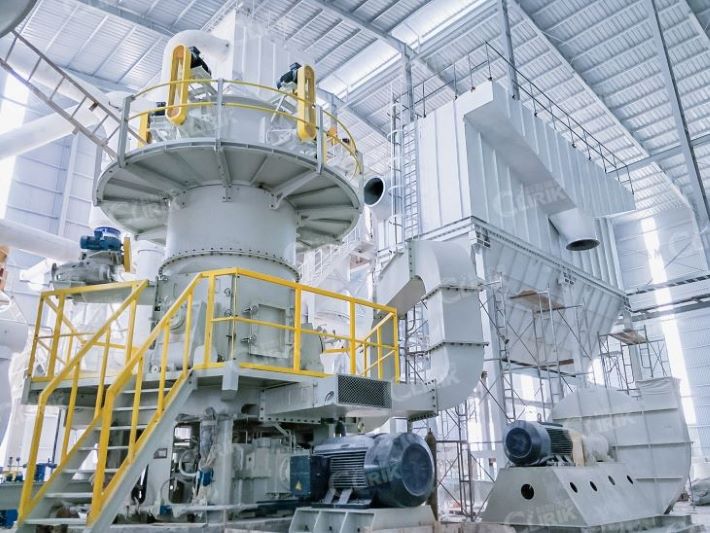Ultrafine vertical mill for processing limestone powder
What determines the fineness of the output
The fineness of the finished material in the production of limestone ultra-fine vertical mills is an important indicator pursued by users, and there are two devices for adjusting the fineness of finished materials in the ultra-fine vertical mill, one is the grinding part and the other is the powder separator. Let's take a look at the ultrafine vertical mill's classifier that determines the fineness of limestone powder.The primary factor in the fineness of the finished limestone powder is the distance between the grinding roller and the grinding disc. The distance between the two determines the particle size of the material to be ground and also determines the fineness of the finished material. The distance between the ultra-fine vertical grinding roller and the grinding disc needs to be adjusted by the limit device in the mill. The limit device is to meet the user's requirements for the fineness of the material, and to avoid direct contact between the grinding disc and the grinding roller. It is set for wear caused by contact.
In the production of limestone, the ultra-fine vertical mill requires different fineness of the finished material, and this fineness adjustment needs to be realized by the distance between the grinding disc and the grinding roller, so a limit device is installed. When the distance between the grinding disc and the grinding roller becomes larger, the material will have larger particles due to insufficient grinding. When the distance between the two becomes smaller, the fineness of the finished material will become finer.
The ultrafine vertical mill is used to process limestone powder. Another factor of the fineness is the speed of the classifier. The rotation speed of the classifier plays a role of secondary check. When the ground material is brought to the classifier with the wind During processing, some materials can pass through the powder separator, while others cannot. This plays a role in the powder selection and also determines the fineness of the finished material.
The speed of the powder separator of the ultra-fine vertical mill can be adjusted by itself. When the speed of the powder separator is high, the material of the same fineness and the same wind cannot pass through the powder separator, and can only fall into the grinding cavity for grinding , And large-fine limestone powder materials are also small-particle materials that can pass through the classifier under the same speed and the same wind force, so as to achieve the purpose of powder selection and also complete the adjustment of the fineness of the finished material.
In addition to the above factors, which can affect the adjustment of the fineness of the finished material of limestone processed by the ultra-fine vertical mill, the various properties of the ultra-fine vertical mill and the composition of parts and components will also affect the fineness of the finished material. The design, process, system and equipment of Liming Heavy Industry's limestone ultrafine vertical milling system should have reliable quality and technology, high availability, less energy consumption and meet environmental protection requirements.

How to deal with the fan phenomenon?
Generally speaking, passing powder is a phenomenon in which qualified grinding particles are not screened out, but return to the mill to continue to receive grinding. The phenomenon of over-powdering will directly cause the amount of fine powder in a warehouse when the vertical mill is processing limestone. Increase, decrease in grinding quality. The occurrence of the over-powder phenomenon is usually greatly related to the material flow rate in the mill and the amount of fine powder, so we will be more targeted when solving the over-powder phenomenon. So, how to deal with the problem of over-pulverization in the limestone powder processed by the ultrafine vertical mill?1. Strengthen the ventilation in the mill
Good ventilation can take away the fine powder produced in time and effectively remove the buffering effect of fine limestone powder. Good ventilation can also make the water vapor in the mill be taken away in time, can effectively reduce the occurrence of adhesion phenomenon, and can also make the screen holes less likely to be blocked. Enhancing the ventilation in the ultra vertical mill also helps to reduce the temperature and greatly increase the output of limestone powder.
2. Add grinding aids
The grinding aid can be effectively adsorbed on the surface of the material, making it difficult to bond between the materials. The grinding aid can also be adsorbed between the cracks of the limestone particles, effectively weakening the "healing effect", speeding up the flow rate of the material in the mill, reducing the residence time of the limestone material in the ultra vertical mill, and reducing the occurrence of over-powdering.
3. The choice of liner
The liner of the vertical mill plays a very important role in the grinding effect. The use of spiral liners or grooved liners and other new liners can effectively reduce the occurrence of over-powdering, because these new liners The plates have a good selective grinding effect.
